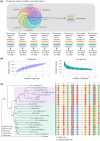The core genome evolution of Lactobacillus crispatus as a driving force for niche competition in the human vaginal tract
- PMID: 37491806
- PMCID: PMC10443340
- DOI: 10.1111/1751-7915.14305
The core genome evolution of Lactobacillus crispatus as a driving force for niche competition in the human vaginal tract
Abstract
The lower female reproductive tract is notoriously dominated by Lactobacillus species, among which Lactobacillus crispatus emerges for its protective and health-promoting activities. Although previous comparative genome analyses highlighted genetic and phenotypic diversity within the L. crispatus species, most studies have focused on the presence/absence of accessory genes. Here, we investigated the variation at the single nucleotide level within protein-encoding genes shared across a human-derived L. crispatus strain selection, which includes 200 currently available human-derived L. crispatus genomes as well as 41 chromosome sequences of such taxon that have been decoded in the framework of this study. Such data clearly pointed out the presence of intra-species micro-diversities that could have evolutionary significance contributing to phenotypical diversification by affecting protein domains. Specifically, two single nucleotide variations in the type II pullulanase gene sequence led to specific amino acid substitutions, possibly explaining the substantial differences in the growth performances and competition abilities observed in a multi-strain bioreactor culture simulating the vaginal environment. Accordingly, L. crispatus strains display different growth performances, suggesting that the colonisation and stable persistence in the female reproductive tract between the members of this taxon is highly variable.
© 2023 The Authors. Microbial Biotechnology published by Applied Microbiology International and John Wiley & Sons Ltd.
Conflict of interest statement
The authors declare no conflict of interest.
Figures




Similar articles
-
Effect of the vaginal live biotherapeutic LACTIN-V (Lactobacillus crispatus CTV-05) on vaginal microbiota and genital tract inflammation among women at high risk of HIV acquisition in South Africa: a phase 2, randomised, placebo-controlled trial.Lancet Microbe. 2025 Jun;6(6):101037. doi: 10.1016/j.lanmic.2024.101037. Epub 2025 Apr 4. Lancet Microbe. 2025. PMID: 40194532 Free PMC article. Clinical Trial.
-
Insights into host dependency from a chemically defined medium for the human vaginal bacterium Lactobacillus crispatus.Arch Microbiol. 2025 Aug 6;207(9):212. doi: 10.1007/s00203-025-04406-z. Arch Microbiol. 2025. PMID: 40767894 Free PMC article.
-
The activity of cell-free supernatant of Lactobacillus crispatus M247: a promising treatment against vaginal infections.Front Cell Infect Microbiol. 2025 Jun 11;15:1586442. doi: 10.3389/fcimb.2025.1586442. eCollection 2025. Front Cell Infect Microbiol. 2025. PMID: 40568705 Free PMC article.
-
Signs and symptoms to determine if a patient presenting in primary care or hospital outpatient settings has COVID-19.Cochrane Database Syst Rev. 2022 May 20;5(5):CD013665. doi: 10.1002/14651858.CD013665.pub3. Cochrane Database Syst Rev. 2022. PMID: 35593186 Free PMC article.
-
Management of urinary stones by experts in stone disease (ESD 2025).Arch Ital Urol Androl. 2025 Jun 30;97(2):14085. doi: 10.4081/aiua.2025.14085. Epub 2025 Jun 30. Arch Ital Urol Androl. 2025. PMID: 40583613 Review.
Cited by
-
Spontaneously fermented Allium cepa L. as a source of lactic acid bacteria with probiotic potential.Sci Rep. 2025 Jul 17;15(1):25970. doi: 10.1038/s41598-025-10037-7. Sci Rep. 2025. PMID: 40676012 Free PMC article.
-
Optimal Representative Strain selector-a comprehensive pipeline for selecting next-generation reference strains of bacterial species.NAR Genom Bioinform. 2024 Dec 18;6(4):lqae173. doi: 10.1093/nargab/lqae173. eCollection 2024 Dec. NAR Genom Bioinform. 2024. PMID: 39703421 Free PMC article.
-
Seven quick tips for gene-focused computational pangenomic analysis.BioData Min. 2024 Sep 3;17(1):28. doi: 10.1186/s13040-024-00380-2. BioData Min. 2024. PMID: 39227987 Free PMC article.
-
Comparative genomic analysis of bacteriocin genes in Lactobacillus crispatus strains.Sci Rep. 2025 Jul 1;15(1):20798. doi: 10.1038/s41598-025-08321-7. Sci Rep. 2025. PMID: 40594829 Free PMC article.
References
-
- Abdelmaksoud, A.A. , Koparde, V.N. , Sheth, N.U. , Serrano, M.G. , Glascock, A.L. , Fettweis, J.M. et al. (2016) Comparison of Lactobacillus crispatus isolates from Lactobacillus‐dominated vaginal microbiomes with isolates from microbiomes containing bacterial vaginosis‐associated bacteria. Microbiology (Reading), 162(3), 466–475. Available from: https://pubmed.ncbi.nlm.nih.gov/26747455/ - PMC - PubMed
-
- Argentini, C. , Fontana, F. , Alessandri, G. , Lugli, G.A. , Mancabelli, L. , Ossiprandi, M.C. et al. (2022) Evaluation of modulatory activities of Lactobacillus crispatus strains in the context of the vaginal microbiota. Microbiology Spectrum, 10(2), e0273321. Available from: https://pubmed.ncbi.nlm.nih.gov/35266820/ - PMC - PubMed
-
- Bankevich, A. , Nurk, S. , Antipov, D. , Gurevich, A.A. , Dvorkin, M. , Kulikov, A.S. et al. (2012) SPAdes: a new genome assembly algorithm and its applications to single‐cell sequencing. Journal of Computational Biology, 19(5), 455–477. Available from: https://pubmed.ncbi.nlm.nih.gov/22506599/ - PMC - PubMed
-
- Blum, H.E. (2017) The human microbiome. Advances in Medical Sciences, 62(2), 414–420. Available from: https://pubmed.ncbi.nlm.nih.gov/28711782/ - PubMed
-
- Bohbot, J.M. , Daraï, E. , Bretelle, F. , Brami, G. , Daniel, C. & Cardot, J.M. (2018) Efficacy and safety of vaginally administered lyophilized Lactobacillus crispatus IP 174178 in the prevention of bacterial vaginosis recurrence. Journal of Gynecology Obstetrics and Human Reproduction, 47(2), 81–86. Available from: https://pubmed.ncbi.nlm.nih.gov/29196153/ - PubMed
MeSH terms
LinkOut - more resources
Full Text Sources
Molecular Biology Databases

